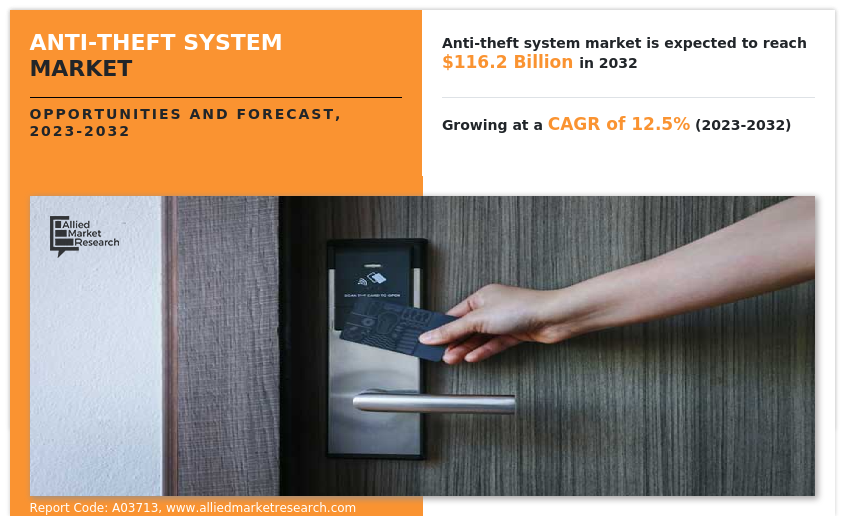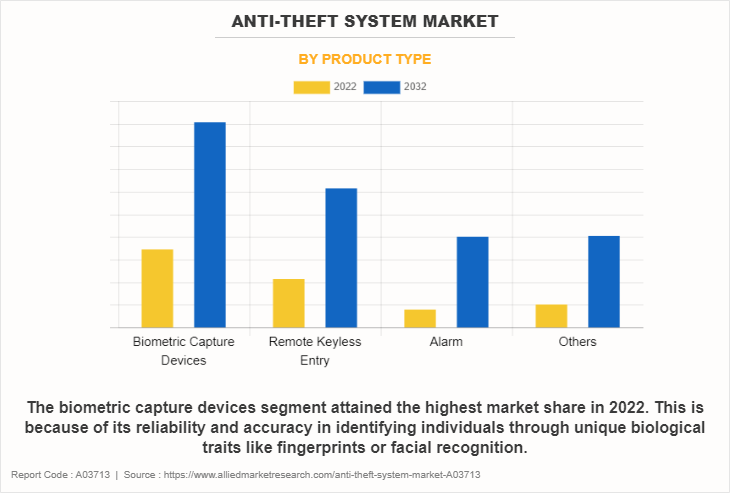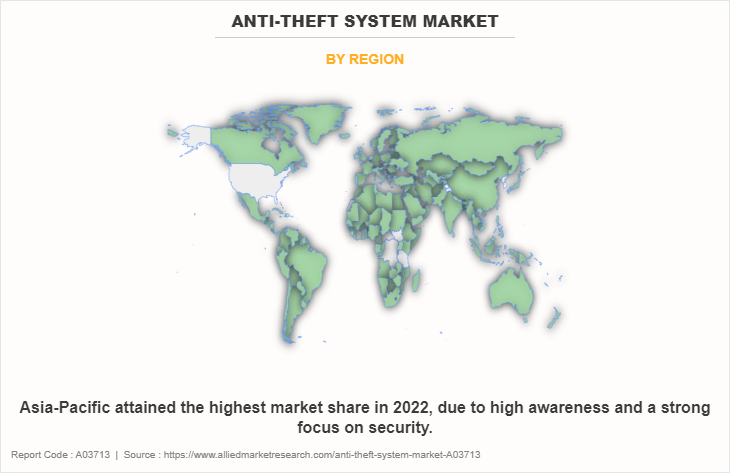Anti-Theft System Market Statistics: 2032
The global anti-theft system market was valued at $36.8 billion in 2022, and is projected to reach $116.2 billion by 2032, growing at a CAGR of 12.5% from 2023 to 2032.
The anti-theft system market experiences dynamic growth driven by escalating security concerns due to rising crime rates across residential, commercial, and industrial sectors. These concerns increase the demand for more sophisticated security measures, bolstered by rapid technological advancements including surveillance, biometrics, IoT, and AI. However, while technological progress propels innovation, the anti-theft market faces major growth restraints due to high cost implications, where the affordability of advanced systems remains a challenge for smaller businesses and individuals.
In addition, ethical considerations and privacy concerns around intrusive surveillance technologies pose significant hurdles. However, integration of AI and ML created growth opportunities for the market, enabling predictive analysis, adaptive responses, and enhanced security measures. This integration not only addresses evolving security threats but also fosters innovation, presenting a pathway for more intelligent, efficient, and competitive anti-theft systems in the market.

An anti-theft system refers to a comprehensive set of security measures designed to prevent unauthorized access to, or theft of, an object, property, or information. It typically employs various technologies, mechanisms, and strategies to deter potential thieves or intruders and protect valuable assets. These systems include a wide range of tools such as alarms, surveillance cameras, access control systems, GPS trackers, immobilizers, and authentication mechanisms. Their primary objective is to detect, deter, and mitigate theft or unauthorized access by creating layers of protection and implementing proactive measures. By utilizing a combination of physical barriers and technological solutions, an anti-theft system aims to enhance security, provide peace of mind, and safeguard against potential losses or unauthorized use.
The report focuses on growth prospects, restraints, and trends of the anti-theft system market analysis. The study provides Porter’s five forces analysis to understand the impact of various factors, such as bargaining power of suppliers, competitive intensity of competitors, threat of new entrants, threat of substitutes, and bargaining power of buyers, on the anti-theft system market.
Top Impacting Factors
Rising Crime Rates and Security Concerns
As crime rates evolve and diversify, there is a growing need for robust anti-theft systems. Surge in theft, burglary, and unauthorized access incidents across residential, commercial, and industrial sectors acts as a strong driver for the anti-theft system market. Heightened security concerns among individuals, businesses, and communities drive the demand for more sophisticated, reliable, and comprehensive security solutions. This demand fuels innovation and development in anti-theft technologies, fostering a competitive market landscape with a focus on advanced security measures.
Cost Implications and Affordability
One of the primary restraints for the anti-theft system market growth is the cost associated with acquiring and implementing comprehensive security solutions. Advanced technologies often come with higher price tags, making them less accessible for smaller businesses or individuals with limited budgets. The initial investment, installation, maintenance, and periodic upgrades contribute to the overall cost, potentially deterring some consumers from investing in top-tier anti-theft systems. Balancing cost-effectiveness with security features remains a challenge for both consumers and providers in the market.
Integration of Artificial Intelligence (AI) and Machine Learning (ML)
The opportunity for the anti-theft system market size lies in leveraging AI and ML capabilities to enhance the effectiveness of anti-theft systems. AI-powered algorithms enable predictive analysis, enabling systems to recognize patterns, detect anomalies, and respond proactively to potential threats. Machine learning algorithms continuously improve by learning from data, thereby optimizing security measures and reducing false alarms. Integration of AI and ML into anti-theft systems offers significant opportunities for more intelligent, adaptive, and efficient security solutions that can stay ahead of evolving security threats. This integration offers a competitive edge and opens avenues for innovation and the market growth.
Segment Review
The anti-theft system market outlook is segmented on the basis of component, product type, industry vertical and region. On the basis of component, the market is segmented into hardware, software and services. Based on product type, the anti-theft system industry is divided into biometric capture devices, remote keyless entry, alarm, and others. Based on industry vertical, the market is segmented into automotive, BFSI, consumers electronics, government, retail, and others. On the basis of region, it is analyzed across North America, Europe, Asia-Pacific, and LAMEA.

On the basis of product type, the biometric capture devices segment attained the highest market share in the anti-theft system industry in 2022, owing to its reliability and accuracy in identifying individuals through unique biological traits like fingerprints or facial recognition. These devices offer a robust layer of security, gaining popularity across various sectors due to their effectiveness in preventing unauthorized access or theft.
However, the alarm segment is expected to be the fastest-growing segment during the forecast period, owing to its versatility and advancements in technology. Modern alarm systems now integrate with smart devices, offering remote monitoring and instant alerts, making them increasingly attractive to consumers seeking easy-to-use yet comprehensive security solutions. As technology evolves, alarms become more sophisticated, driving their rapid growth in the market.

Region-wise, Asia-Pacific attained the highest growth in 2022, and it is expected to be the fastest-growing segment during the forecast period due to the unfortunate increase in vehicle thefts and related crimes. This rise in criminal activities has pushed both individuals and businesses to prioritize security measures, boosting the demand for reliable anti-theft systems.
In addition, governmental regulations and initiatives to curb these crimes have further incentivized the adoption of these security technologies. As a response to this pressing issue, the market for anti-theft systems in Asia-Pacific has experienced substantial growth as people seek effective ways to protect their vehicles and assets.
Competition Analysis
The report analyzes the profiles of key players operating in the anti-theft system market share such as ADT, ASSA ABLOY, CP Plus Corporation, Dahua Technology Co., Ltd, GALLAGHER GROUP LIMITED, Godrej, Hangzhou Hikvision Digital Technology Co., Ltd., Honeywell International Inc., Securitas AB, and Tyco Security Products. These players have adopted various strategies to increase their market penetration and strengthen their position in the anti-theft system market.
Recent Product Launches in the Anti-theft system Market
On January 18, 2022, Automaker Ford and ADT, a company that provides home and business security and alarm monitoring services, have launched a joint venture called Canopy that aims to address vulnerabilities in current vehicle security offerings. Canopy will initially offer an aftermarket accessory that can be mounted onto a vehicle to monitor its surroundings and alert drivers of issues like theft or vandalism.
On July 18, 2023, Versuni, formerly known as Philips domestic appliances has expanded into home safety products. The latest range includes three smartsecurity cameras and a new Home Safety app. The company claims that the Philips Home Safety solutions will combine artificial intelligence, user-friendliness and reliability to offer users “a range of benefits.” Philips’ latest security cameras will come with smart capabilities that will be able to differentiate between motion, noise and people.
Key Benefits for Stakeholders
- This report provides a quantitative analysis of the market segments, current trends, estimations, and dynamics of the anti-theft system market forecast from 2023 to 2032 to identify the prevailing anti-theft system market opportunity.
- Market research is offered along with information related to key drivers, restraints, and opportunities.
- Porter's five forces analysis highlights the potency of buyers and suppliers to enable stakeholders to make profit-oriented business decisions and strengthen their supplier-buyer network.
- In-depth analysis of the anti-theft system market segmentation assists to determine the prevailing market opportunities.
- Major countries in each region are mapped according to their revenue contribution to the global market.
- Market player positioning facilitates benchmarking and provides a clear understanding of the present position of the market players.
- The report includes an analysis of the regional as well as global anti-theft system market trends, key players, market segments, application areas, and market growth strategies.
Anti-Theft System Market Report Highlights
| Aspects | Details |
| Market Size By 2032 | USD 116.2 billion |
| Growth Rate | CAGR of 12.5% |
| Forecast period | 2022 - 2032 |
| Report Pages | 432 |
| By Component |
|
| By Product Type |
|
| By Industry Verticals |
|
| By Region |
|
| Key Market Players | CP Plus Corporation, Dahua Technology Co., Ltd., Hangzhou Hikvision Digital Technology Co., Ltd., Godrej, Securitas AB, ASSA ABLOY, GALLAGHER GROUP LIMITED, ADT, Honeywell International Inc., Tyco Security Products |
Analyst Review
Several key growth factors propel the expansion of the anti-theft system market. The persistent rise in theft, burglary, and unauthorized access incidents across diverse sectors fuels the demand for advanced security solutions. Rise in awareness among individuals and businesses about the importance of safeguarding assets and sensitive information increases the need for installation of anti-theft systems. Furthermore, technological advancements, particularly in surveillance, biometrics, IoT, and artificial intelligence, empower the development of smarter, more responsive, and adaptable security systems. These innovations enhance detection capabilities, reduce false alarms, and offer intuitive interfaces, thus, driving the market growth. Moreover, regulatory mandates enforcing the installation of anti-theft systems, along with insurance incentives, incentivize compliance and investment in comprehensive security measures. Moreover, the integration of AI and machine learning into security systems presents a substantial growth avenue, enabling predictive analysis and adaptive responses to evolving security threats. These factors collectively contribute to the robust expansion of the anti-theft system market, fostering innovation and meeting the escalating security needs of various industries and consumers.
Some key players profiled in the report include ADT, ASSA ABLOY, CP Plus Corporation, Dahua Technology Co., Ltd, GALLAGHER GROUP LIMITED, Godrej, Hangzhou Hikvision Digital Technology Co., Ltd., Honeywell International Inc., Securitas AB, and Tyco Security Products. These players have adopted various strategies to increase their market penetration and strengthen their position in the anti-theft system market.
Several major trends are reshaping the landscape of the anti-theft systems market, as there is a notable shift towards integrated and interconnected security solutions. This trend involves the convergence of various technologies such as AI, IoT, and cloud-based systems to create more comprehensive and adaptable security ecosystems.
Their primary objective is to detect, deter, and mitigate theft or unauthorized access by creating layers of protection and implementing proactive measures. By utilizing a combination of physical barriers and technological solutions, an anti-theft system aims to enhance security, provide peace of mind, and safeguard against potential losses or unauthorized use.
Asia-Pacific is the largest regional market for Anti-Theft System
The estimated industry size of Anti-Theft System is projected to reach $116,154.89 million by 2032, growing at a CAGR of 12.5% from 2023 to 2032.
The top companies to hold the market share in Anti-Theft System are ADT, ASSA ABLOY, CP Plus Corporation, Dahua Technology Co., Ltd, GALLAGHER GROUP LIMITED, Godrej, Hangzhou Hikvision Digital Technology Co., Ltd., Honeywell International Inc., Securitas AB, and Tyco Security Products
Loading Table Of Content...
Loading Research Methodology...



